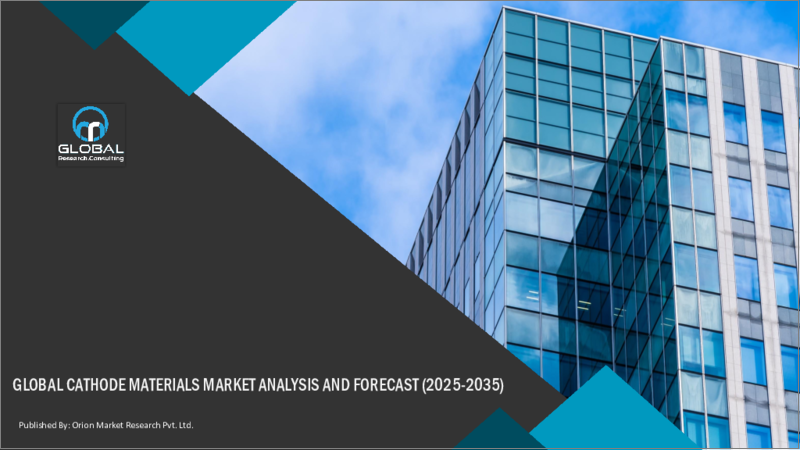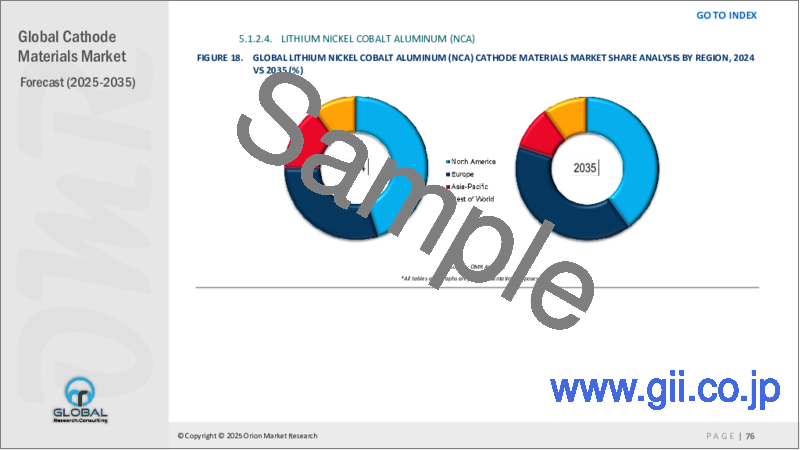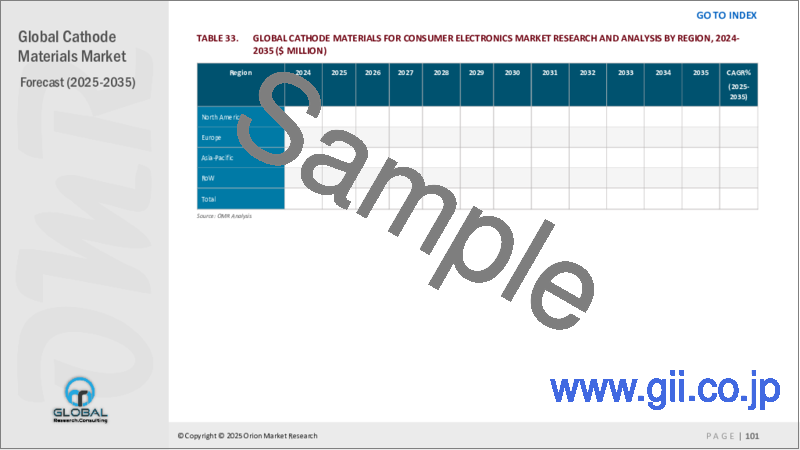|
|
市場調査レポート
商品コード
1610997
正極材の世界市場:2024~2031年Global Cathode Materials Market 2024-2031 |
||||||
カスタマイズ可能
|
|||||||
| 正極材の世界市場:2024~2031年 |
|
出版日: 2024年11月20日
発行: Orion Market Research
ページ情報: 英文 170 Pages
納期: 2~3営業日
|
- 全表示
- 概要
- 図表
- 目次
世界の正極材市場規模、シェア、動向:材料別(NMC正極材、リチウム正極材、二酸化リチウム正極材、その他正極材(リチウム硫黄、コバルト酸ナトリウム))、電池タイプ別(リチウムイオン、鉛蓄電池、ニッケルカドミウム、その他(空気亜鉛、ニッケルメタル、固体))、流通チャネル別(自動車、家電、エネルギー・電力、ヘルスケア、産業)予測期間(2024-2031年)分析レポート
正極材市場は予測期間(2024-2031年)にCAGR 15.2%で成長すると予測されます。正極材市場は、電気自動車、家電製品、エネルギー貯蔵システムで使用される高性能バッテリーの生産に不可欠です。電気自動車(EV)の需要増加、電池技術の進歩、再生可能エネルギーや環境に優しい技術を促進する政府の奨励策により、大きな成長が見込まれています。さらに、現在の市場動向には、高エネルギー密度正極へのシフトが含まれ、代替正極材の市場開拓が市場需要に影響を与えると予想されます。
市場力学
EV普及の高まり
正極材に対する需要の高まりは、世界のEV採用の増加によって後押しされています。このため、相手先商標製品製造業者(OEM)や電池メーカーは、貯蔵能力と性能を向上させた電池材料の開発により多くの投資を行うようになっています。EVの需要が急増し続ける中、自動車メーカーと電池メーカーは、旧モデルに比べて航続距離を伸ばし、より優れた性能を提供する電池をより速い速度で組み込もうと努力しており、正極材メーカーには十分な開発余地があります。例えば、国際エネルギー機関(IEA)によると、EV用バッテリーの需要は2023年も上昇を続け、2022年から40.0%増の750GWh以上に達しました。この伸びは主に電気自動車販売によるもので、増加分の95.0%を占めています。米国と欧州のEV市場が最も急速に成長し、中国が僅差でこれに続いた。2023年には、世界のその他の地域でも電池需要が急増し、2022年比で70.0%以上増加したが、これは主にEV販売の増加による。
正極材開発への投資の増加
正極材開発への投資の増加は、正極材市場の成長を大きく促進しています。電池技術に注力する多くの業界や政府は、電池材料科学の研究開発にリソースを割いています。これにより、エネルギー密度が高く寿命の長い先進的な正極が生み出されています。この投資拡大は、リチウムニッケルコバルトマンガン酸化物(NCM)やリチウムニッケルコバルトアルミニウム酸化物(NCA)など、EVや携帯電子機器に使用される高性能電池にとって重要な最先端材料の開発を支えています。さらに、研究開発資金の増加により、技術革新が加速し、コストが削減され、新しい正極技術の実現可能性が向上し、堅調な市場成長が見込まれます。例えば、電池材料と技術の主要企業であるノボニックス・リミテッドは2023年9月、カナダのノバスコシア州にある同社のバッテリー技術ソリューション部門が、カナダ国立研究会議産業研究支援プログラム(NRC IRAP)から最大220万米ドルの研究開発資金とアドバイザリー・サービスを受けると発表しました。この資金は、同社の電池材料・技術プロジェクトの強化を目的とした2つの重要な研究開発イニシアチブの推進に使用されます。これらの取り組みには、オールドライで廃棄物ゼロの正極材の開発とパイロットライン、およびリチウムイオン電池の寿命を予測する新技術が含まれます。
セグメント別展望
- 材料別では、市場はNMC正極材、リチウム正極材、二酸化リチウム正極材、その他の正極材(リチウム硫黄、コバルト酸ナトリウム)に区分されます。
- 電池タイプ別では、市場はリチウムイオン、鉛酸、ニッケルカドミウム、その他(空気亜鉛、ニッケルメタル、固体)に区分されます。
- エンドユーザー別では、自動車、家電、エネルギー・電力、ヘルスケア、産業用に区分されます。
リチウムイオンが好ましい電池タイプ
リチウムイオン電池は、エネルギー密度が高く、サイクル寿命が長く、自己放電率が比較的低いため、正極材市場で好まれるタイプです。この分野の成長要因には、リチウムイオン技術の進歩、民生・産業両分野における効率的で信頼性の高いエネルギー貯蔵ソリューションに対する需要の増加、リチウムイオン電池の相対的な費用対効果などがあります。例えば、国際エネルギー機関(IEA)によると、自動車用リチウムイオン(Li-ion)電池の需要は、2021年の約330GWhから2022年には550GWhへと約65.0%増加しました。これは主に、電気乗用車の販売台数が増加した結果であり、2022年の新規登録台数は2021年比で55.0%増加しました。
自動車が最大のエンドユーザー・セグメント
正極材市場における最大のエンドユーザーセグメントは自動車であり、これはEVの需要が急増しているためです。このセグメントの成長要因には、自動車用電池技術の進歩、電動モビリティと持続可能性を促進する政府のインセンティブと政策、EVへの消費者シフトの増加が含まれます。例えば、国際エネルギー機関(IEA)によると、中国では自動車用バッテリー需要が70.0%以上増加し、電気自動車販売台数は2022年に2021年比で80.0%増加したが、バッテリー需要の伸びはPHEVのシェア増加によって若干抑えられています。米国の自動車用電池需要は約80.0%増加したが、2022年の電気自動車販売台数は約55.0%の増加にとどまった。
地域別展望
世界の正極材市場は、北米(米国、カナダ)、欧州(英国、イタリア、スペイン、ドイツ、フランス、その他欧州地域)、アジア太平洋(インド、中国、日本、韓国、その他アジア太平洋地域)、世界のその他の地域(中東とアフリカ、中南米)を含む地域別にさらに区分されます。
アジア太平洋地域が世界の正極材市場を独占すると予測される
アジア太平洋地域は、将来的に正極材市場を独占すると予測されています。これは、同地域におけるEV市場の急速な拡大、電池材料の開発と技術への投資の増加、同地域における電池開発のための支援的な規制エコシステム、および同地域における電気・電子部品インフラストラクチャーの構築のための地域開発の焦点の増加によるものです。例えば、2024年5月、電池材料ソリューションの世界的プロバイダーであるイプシロン・アドバンスト・マテリアルズ(EAM)は、5億8,800万米ドルの正極工場を建設するため、インドで土地を取得する選択肢を模索していると述べた。同社は現在、カルナタカ州、タミル・ナードゥ州、テランガナ州を含む5つの州で候補地を評価しており、来年までに商業生産を開始する意向です。この構想は、EAMが1月にドイツでリン酸リチウムイオン(LFP)正極活物質の技術センターを買収したことに続くものです。
世界の正極材市場に参入している主要企業には、BASF SE, Ecopro Co., Ltd., POSCO FUTURE M Co., Ltd. Sumitomo Metal Mining Co., Ltd., and Umicore,などです。市場企業は、コラボレーション、パートナーシップ、市場拡大などの戦略を採用することで、成長への資本注入に注力しています。
最近の動向
- 2023年2月、LG Chemはゼネラルモーターズ(GM)と25兆ウォン(191億米ドル)相当の正極材長期供給契約を締結しました。このパートナーシップは、米国テネシー州にあるLG Chemの正極工場を世界の電池材料市場の生産拠点として活用することで、北米市場での協力を強化することを目的としています。LG化学は2026年から2035年まで、1回の充電で航続距離500kmの高性能純EV500万台分に相当する50万トン以上の正極材をGMに供給します。
目次
第1章 レポート概要
- 業界の現状分析と成長ポテンシャルの展望
- 調査方法とツール
- 市場内訳
- セグメント別
- 地域別
第2章 市場概要と洞察
- 調査範囲
- アナリストの洞察と現在の市場動向
- 主要業界動向
- 推奨事項
- 結論
第3章 競合情勢
- 主要企業分析
- 概要
- 財務分析
- SWOT分析
- 最近の動向
- 主要戦略分析
第4章 市場セグメンテーション
- 正極材の世界市場:材料別
- NMC正極材
- リチウム正極材
- リン酸リチウム(LFP)
- コバルト酸リチウム(LCO)
- ニッケルマンガンコバルトリチウム(NMC)
- リチウムニッケルコバルトアルミニウム(NCA)
- 酸化マンガンリチウム(LMO)
- 二酸化リチウム正極材
- その他の正極材(硫黄リチウム、コバルト酸ナトリウム)
- 正極材の世界市場:電池タイプ別
- リチウムイオン
- 鉛酸
- ニッケルカドミウム
- その他(空気亜鉛、金属ニッケル、ソリッドステート)
- 正極材の世界市場:エンドユーザー別
- 自動車
- 消費者用電子機器
- エネルギー・電力
- ヘルスケア
- 産業用
第5章 地域分析
- 北米
- 米国
- カナダ
- 欧州
- 英国
- ドイツ
- イタリア
- スペイン
- フランス
- その他欧州
- アジア太平洋
- 中国
- インド
- 日本
- 韓国
- その他アジア太平洋地域
- 世界のその他の地域
- ラテンアメリカ
- 中東・アフリカ
第6章 企業プロファイル
- Aleees
- Altmin Pvt. Ltd.
- American Elements
- Ascend Elements, Inc.
- BASF SE
- Ecopro Co., Ltd.
- Epsilon Advanced Materials Pvt. Ltd.
- Finnish Minerals Group
- Ganfeng Lithium Group Co., Ltd
- Guizhou Zhenhua New Materials
- Huayou Cobalt Co., Ltd.
- Hunan Changyuan Lithium Technology Co., Ltd.
- L&F CORP.
- LG Chem Ltd.
- Macsen Laboratories
- Nantong Ruixiang New Materials Co., Ltd.
- NICHIA CORP.
- NEI Corp.
- POSCO FUTURE M Co., Ltd.
- Redwood Materials, Inc.
- Shanshan Co.
- Shenzhen Dynanonic Co., Ltd.
- Sumitomo Metal Mining Co., Ltd.
- Tanaka Chemical Corp.
- Targray Technology International Inc.
- Tianqi Lithium Co., Ltd.
- TexPower EV Technologies, Inc.
- TODA KOGYO CORP.
- Umicore
- Xiamen Acey New Energy Technology Co., Ltd.
- Xiamen Tmax Battery Equipments Ltd.
LIST OF FIGURES
- 1. Global Cathode Materials Market Share By Material, 2023 Vs 2031 (%)
- 2. Global NMC Cathode Materials Market Share By Region, 2023 Vs 2031 (%)
- 3. Global Lithium Cathode Materials Market Share By Region, 2023 Vs 2031 (%)
- 4. Global Lithium Dioxide Cathode Materials Market Share By Region, 2023 Vs 2031 (%)
- 5. Global Other Cathode Materials Market Share By Region, 2023 Vs 2031 (%)
- 6. Global Cathode Materials Market Share By Battery Type, 2023 Vs 2031 (%)
- 7. Global Cathode Materials For Lithium-Ion Market Share By Region, 2023 Vs 2031 (%)
- 8. Global Cathode Materials For Lead Acid Market Share By Region, 2023 Vs 2031 (%)
- 9. Global Cathode Materials For Nickel Cadmium Market Share By Region, 2023 Vs 2031 (%)
- 10. Global Cathode Materials For Other Battery Type Market Share By Region, 2023 Vs 2031 (%)
- 11. Global Cathode Materials Market Share By End-User, 2023 Vs 2031 (%)
- 12. Global Cathode Materials For Automotive Market Share By Region, 2023 Vs 2031 (%)
- 13. Global Cathode Materials For Consumer Electronics Market Share By Region, 2023 Vs 2031 (%)
- 14. Global Cathode Materials For Energy & Power Market Share By Region, 2023 Vs 2031 (%)
- 15. Global Cathode Materials For Healthcare Market Share By Region, 2023 Vs 2031 (%)
- 16. Global Cathode Materials For Industrial Market Share By Region, 2023 Vs 2031 (%)
- 17. US Cathode Materials Market Size, 2023-2031 ($ Million)
- 18. Canada Cathode Materials Market Size, 2023-2031 ($ Million)
- 19. UK Cathode Materials Market Size, 2023-2031 ($ Million)
- 20. France Cathode Materials Market Size, 2023-2031 ($ Million)
- 21. Germany Cathode Materials Market Size, 2023-2031 ($ Million)
- 22. Italy Cathode Materials Market Size, 2023-2031 ($ Million)
- 23. Spain Cathode Materials Market Size, 2023-2031 ($ Million)
- 24. Rest Of Europe Cathode Materials Market Size, 2023-2031 ($ Million)
- 25. India Cathode Materials Market Size, 2023-2031 ($ Million)
- 26. China Cathode Materials Market Size, 2023-2031 ($ Million)
- 27. Japan Cathode Materials Market Size, 2023-2031 ($ Million)
- 28. South Korea Cathode Materials Market Size, 2023-2031 ($ Million)
- 29. Rest Of Asia-Pacific Cathode Materials Market Size, 2023-2031 ($ Million)
- 30. Latin America Cathode Materials Market Size, 2023-2031 ($ Million)
- 31. Middle East And Africa Cathode Materials Market Size, 2023-2031 ($ Million)
Global Cathode Materials Market Size, Share & Trends Analysis Report by Material (NMC Cathode Materials, Lithium Cathode Materials, Lithium Dioxide Cathode Materials, And Other Cathode Materials (Lithium Sulfur, Sodium Cobalt Oxide)), by Battery Type (Lithium-ion, Lead Acid, Nickel Cadmium, and Others (Zinc Air, Nickel Metal, Solid State)), and by Distribution Channel (Automotive, Consumer Electronics, Energy & Power, Healthcare, and Industrial) Forecast Period (2024-2031)
Cathode material market is anticipated to grow at a CAGR of 15.2% during the forecast period (2024-2031). The cathode material market is crucial for producing high-performance batteries used in electric vehicles, consumer electronics, and energy storage systems. It is expected to experience significant growth owing to the increasing demand for Electric Vehicles (EVs), advancements in battery technology, and government incentives to promote renewable energy and greener technologies. Further, the current market trends include a shift towards high-energy-density cathodes, and the development of alternative cathode materials is expected to influence the market demand.
Market Dynamics
Rising EV Adoption
The growing demand for cathode material is fueled by the increasing adoption of EVs globally. This has prompted Original Equipment Manufacturers (OEMs) and battery manufacturers to invest more in developing battery materials with improved storage and performance capabilities. As the demand for EVs continues to rise rapidly, vehicle and battery manufacturers are striving to incorporate batteries that offer increased range and better performance compared to older models at a faster rate, creating ample scope for development for the cathode material manufacturers. For instance, as per the International Energy Agency (IEA), the demand for EV batteries continued to rise in 2023, reaching over 750 GWh, which is a 40.0% increase from 2022. This growth was mainly driven by electric car sales, accounting for 95.0% of the increase. The US and Europe experienced the fastest growth in EV markets, followed closely by China. In 2023, the rest of the world also saw a surge in battery demand, with an increase of over 70.0% compared to 2022, largely due to rising EV sales.
Increasing Investment in Cathode Material Development
The growing investment in developing cathode material is significantly driving the growth of the cathode material market. Many industries and governments focused on battery technology have allocated resources to R&D in battery material science. This has led to the creation of advanced cathodes with higher energy density and longer lifespans. This increased investment supports the development of cutting-edge materials such as lithium nickel cobalt manganese oxide (NCM) and lithium nickel cobalt aluminum oxide (NCA), which are important for high-performance batteries used in EVs and portable electronics. Moreover, increased R&D funding is expected to accelerate innovation, reduce costs, and improve the viability of new cathode technologies, leading to robust market growth. For instance, in September 2023, NOVONIX Limited, a leading battery materials and technology company, announced that its Battery Technology Solutions division in Nova Scotia, Canada, will be receiving up to $2.2 million in R&D funding and advisory services from the National Research Council of Canada Industrial Research Assistance Program (NRC IRAP). The funding will be used to advance two important R&D initiatives aimed at enhancing its battery materials and technology projects. These initiatives include the company's all-dry, zero-waste cathode materials development and pilot line, as well as a new technology to predict the lifespan of lithium-ion batteries.
Segmental Outlook
- Based on material, the market is segmented into NMC cathode materials, lithium cathode materials, lithium dioxide cathode materials, and other cathode materials (lithium-sulfur, sodium cobalt oxide).
- Based on battery type, the market is segmented into lithium-ion, lead acid, nickel cadmium, and others (zinc-air, nickel metal, solid-state).
- Based on end-users, the market is segmented into automotive, consumer electronics, energy & power, healthcare, and industrial.
Lithium-ion is the Preferred Battery Type
Lithium-ion batteries are the preferred type in the cathode material market owing to their high energy density, long cycle life, and relatively low self-discharge rates. The segmental growth factors include advancements in lithium-ion technology, the increasing demand for efficient, reliable energy storage solutions in both consumer and industrial sectors, and the relative cost-effectiveness of lithium-ion batteries. For instance, as per the International Energy Agency, automotive lithium-ion (Li-ion) battery demand increased by about 65.0% to 550 GWh in 2022 from about 330 GWh in 2021, primarily as a result of growth in electric passenger car sales, with new registrations increasing by 55.0% in 2022 relative to 2021.
Automotive is the Biggest End-User Segment
The automotive sector is the biggest end-user segment in the cathode material market owing to the surging demand for EVs, which require high-performance batteries for extended range and efficiency. The segmental growth factors include advancements in automotive battery technology, government incentives and policies promoting electric mobility and sustainability, and increasing consumer shift towards EVs. For instance, as per the International Energy Agency, in China, battery demand for vehicles grew by over 70.0%, while electric car sales increased by 80.0% in 2022 relative to 2021, with growth in battery demand slightly tempered by an increasing share of PHEVs. Battery demand for vehicles in the United States grew by around 80.0%, despite electric car sales only increasing by around 55.0% in 2022.
Regional Outlook
The global cathode materials market is further segmented based on geography including North America (the US, and Canada), Europe (the UK, Italy, Spain, Germany, France, and the Rest of Europe), Asia-Pacific (India, China, Japan, South Korea, and Rest of Asia-Pacific), and the Rest of the World (the Middle East & Africa, and Latin America).
Asia-Pacific is Estimated to Dominate the Global Cathode Materials Market
Asia-Pacific is projected to dominate the cathode material market in the future, attributed to the rapid expansion of the EV market in the region, growing investment in battery material development and technology, a supportive regulatory ecosystem for battery development in the region, and the increasing focus of regional development for creating an electrical and electronics component infrastructure in the region. For instance, in May 2024, Epsilon Advanced Materials (EAM), a global provider of battery material solutions, stated that it is exploring options to acquire land in India for the construction of its $588 million cathode plant. The company is currently evaluating potential locations in five states, including Karnataka, Tamil Nadu, and Telangana, and intends to commence commercial production by next year. This initiative comes on the heels of EAM's recent acquisition of a technology center for lithium-ion phosphate (LFP) cathode active materials in Germany in January.
The major companies serving the global cathode materials market include BASF SE, Ecopro Co., Ltd., POSCO FUTURE M Co., Ltd. Sumitomo Metal Mining Co., Ltd., and Umicore, among others. The market players are focusing on capitalizing on growth by adopting strategies such as collaboration, partnerships, and market expansion among others.
Recent Development
- In February 2023, LG Chem secured a long-term cathode material supply contract with General Motors (GM) worth KRW 25 trillion ($19.1 billion). The partnership aims to strengthen cooperation in the North American market by utilizing LG Chem's cathode plant in Tennessee, US as a production hub for the global battery material market. Beginning in 2026 through 2035, LG Chem will supply GM with more than 500,000 tons of cathode materials, sufficient to power 5 million units of high-performance pure EVs with a range of 500km on a single charge.
Table of Contents
1. Report Summary
- Current Industry Analysis and Growth Potential Outlook
- 1.1. Research Methods and Tools
- 1.2. Market Breakdown
- 1.2.1. By Segments
- 1.2.2. By Region
2. Market Overview and Insights
- 2.1. Scope of the Report
- 2.2. Analyst Insight & Current Market Trends
- 2.2.1. Key Industry Trends
- 2.2.2. Recommendations
- 2.2.3. Conclusion
3. Competitive Landscape
- 3.1. Key Company Analysis
- 3.1.1. Overview
- 3.1.2. Financial Analysis
- 3.1.3. SWOT Analysis
- 3.1.4. Recent Developments
- 3.2. Key Strategy Analysis
4. Market Segmentation
- 4.1. Global Cathode Materials Market by Material
- 4.1.1. NMC Cathode Materials
- 4.1.2. Lithium Cathode Materials
- 4.1.2.1. Lithium Phosphate (LFP)
- 4.1.2.2. Lithium Cobalt Oxide (LCO)
- 4.1.2.3. Lithium Nickel Manganese Cobalt (NMC)
- 4.1.2.4. Lithium Nickel Cobalt Aluminum (NCA)
- 4.1.2.5. Lithium Manganese Oxide (LMO)
- 4.1.3. Lithium Dioxide Cathode Materials
- 4.1.4. Other Cathode Materials (Lithium Sulfur, Sodium Cobalt Oxide)
- 4.2. Global Cathode Materials Market by Battery Type
- 4.2.1. Lithium-ion
- 4.2.2. Lead Acid
- 4.2.3. Nickel Cadmium
- 4.2.4. Others (Zinc Air, Nickel Metal, Solid State)
- 4.3. Global Cathode Materials Market by End-User
- 4.3.1. Automotive
- 4.3.2. Consumer Electronics
- 4.3.3. Energy & Power
- 4.3.4. Healthcare
- 4.3.5. Industrial
5. Regional Analysis
- 5.1. North America
- 5.1.1. United States
- 5.1.2. Canada
- 5.2. Europe
- 5.2.1. UK
- 5.2.2. Germany
- 5.2.3. Italy
- 5.2.4. Spain
- 5.2.5. France
- 5.2.6. Rest of Europe
- 5.3. Asia-Pacific
- 5.3.1. China
- 5.3.2. India
- 5.3.3. Japan
- 5.3.4. South Korea
- 5.3.5. Rest of Asia-Pacific
- 5.4. Rest of the World
- 5.4.1. Latin America
- 5.4.2. Middle East and Africa
6. Company Profiles
- 6.1. Aleees
- 6.2. Altmin Pvt. Ltd.
- 6.3. American Elements
- 6.4. Ascend Elements, Inc.
- 6.5. BASF SE
- 6.6. Ecopro Co., Ltd.
- 6.7. Epsilon Advanced Materials Pvt. Ltd.
- 6.8. Finnish Minerals Group
- 6.9. Ganfeng Lithium Group Co., Ltd
- 6.10. Guizhou Zhenhua New Materials
- 6.11. Huayou Cobalt Co., Ltd.
- 6.12. Hunan Changyuan Lithium Technology Co., Ltd.
- 6.13. L&F CORP.
- 6.14. LG Chem Ltd.
- 6.15. Macsen Laboratories
- 6.16. Nantong Ruixiang New Materials Co., Ltd.
- 6.17. NICHIA CORP.
- 6.18. NEI Corp.
- 6.19. POSCO FUTURE M Co., Ltd.
- 6.20. Redwood Materials, Inc.
- 6.21. Shanshan Co.
- 6.22. Shenzhen Dynanonic Co., Ltd.
- 6.23. Sumitomo Metal Mining Co., Ltd.
- 6.24. Tanaka Chemical Corp.
- 6.25. Targray Technology International Inc.
- 6.26. Tianqi Lithium Co., Ltd.
- 6.27. TexPower EV Technologies, Inc.
- 6.28. TODA KOGYO CORP.
- 6.29. Umicore
- 6.30. Xiamen Acey New Energy Technology Co., Ltd.
- 6.31. Xiamen Tmax Battery Equipments Ltd.






